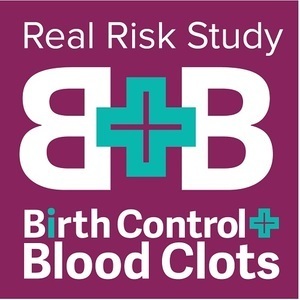Over the better part of the last year we have been collecting data about birth control induced blood clots. This work is part of a multi-phased project to determine a more realistic appraisal of clotting risk than those currently marketed by industry. We know that the synthetic hormones used in birth control increase blood coagulation factors by 170% and decrease anti-coagulation factors by at least 20% in all women who use these products. What we do not know is why some women develop clots relatively quickly after commencing with these medications and others can withstand the changes in hemodynamics for years, sometimes decades, before the clots become problematic.
Industry safety pamphlets tell us that clot risk is increased in women over the age of 35 years, who smoke and/or are overweight, suggesting that for everyone else the risk of clotting is minimal. Similarly, there is a recognition that women with known clotting disorders are at increased risk of birth control induced blood clots (though very rarely are these tested before commencing hormonal birth control). Beyond that however, the major medical societies routinely proclaim the safety of these medications for all women, even women with health issues that should logically preclude the use of hormonal birth control, like those with migraines, high blood pressure, and diabetes.
How is it possible that a class of medications known to alter hemostasis and affect over 50 metabolic reactions (Nelson Pill Hearings, pg. 6311) be considered safe for all, or for anyone really? Politics aside (and yes, we are pro-women’s rights, choice and health), it is difficult to reconcile the very real changes in chemistry with any legitimate conversation about safety. The chemistry predicates the clotting, incontrovertibly. Eventually, the alterations in chemistry induced by hormonal contraceptives are bound to create problems. The only questions that remain are when and with what degree of severity?
These are important questions that one should have answers in advance of deciding to use hormonal contraceptives. Indeed, these questions should have been answered decades ago, but they were not, leaving women to make these decisions based more on faith than on facts. Our mandate for this project is to answer those questions. With Phase 1, the pilot study now complete, patterns are emerging, that if confirmed in Phase 2, may flip what we think we know about hormonal birth control and blood clots, upside down. Namely, who gets clots, the over 35 smoker or the otherwise healthy younger woman? And once those clots develop, who is likely to survive them?
What We Found
Contrary to what we expected, the results from our study showed that it was younger, more active women who developed clots in general, but also who subsequently died from those clots. Our sample size was small and these trends may change with the larger sample size anticipated in Phase 2, but for now, our results are in direct conflict with the stated risks. The women who survive blood clots were older, less active, heavier, and had more cumulative health risks than those for whom the clots were fatal. In addition, NuvaRing was proportionately more likely to correspond with blood clot fatalities than any of the other contraceptive methods.
Why younger women were more likely to clot and subsequently die from blood clots is not yet clear. Clotting disorders did not explain this finding. Two variables that may be indicative, include exercise and alcohol use. Overall the younger women were more active and in the deceased group activity levels were significantly higher than in the survivor group. Similarly, alcohol use though low overall, was higher in the deceased group as well. Both of those variables are known to favor clotting dynamics; then again, so too are smoking and obesity and neither of those variables was significant. Similarly, it is also possible that NuvaRing was uniquely involved, either because of the progestin and/or because of the route of administration. Since NuvaRing tends to be favored with younger women it may be a factor in the younger ages of those who perished. With the larger sample size anticipated in Phase 2 of this project, we’ll be able to more fully delineate these risks. For now, the results tell us that what we think we know about hormonal contraceptives and clotting may require re-evaluation. Described below are the study details.
Birth Control and Blood Clots Pilot Study Results
General Information
Phase 1 of the research involved collecting survey data and case reports from women who have suffered from blood clots while using hormonal birth control and from family members of women who died from birth control induced blood clots. The survey was advertised via social media and respondents completed the survey online. Case histories were collected online and included phone interviews. The final sample included 87 completed surveys, including 77 self-reports and 10 surveys completed by a family member of a deceased woman. This was from a larger pool of 125 partially completed surveys. Case histories were collected from 26 women or families and continue to be collected as part of the second phase of the project.
Demographics
- Average age at diagnosis of blood clot: 31 years (range: 15-52)
- Average duration of birth control usage at time of clot: 8.52 years
- Race/ethnicity of respondents: 90% Caucasian
Type of Event: Primary Diagnosis
- Pulmonary Embolism (PE): 33%
- Deep Vein Thromboembolism (DVT): 19%
- PE plus DVT: 16%
- Stroke: 44%
- Peripheral Artery Disease: 3%
Which Contraceptives Are More Dangerous?
While the small sample size and the possibility of an availability bias in participant recruitment precludes answering this question with confidence, the early trends suggest that the NuvaRing and the drosperinone-based oral contraceptives may pose a higher risk for thrombotic events and NuvaRing may pose a higher risk for fatality. Notably, a significantly higher proportion of the women who died from blood clots were using NuvaRing at the time of their clot than those who survived, 66.7% versus 19.2%, respectively [ X2(2, N=87) =9.985, p = .007]. As the sample size increases in Phase 2 of this project, these data may change and results will become clearer.
- NuvaRing (etonogestrel) -21
- Drospirenone based oral contraceptive (Yaz, Yasmin, Ocella) – 15
- Levonorgestrel based oral contraceptive (LevLen, Seasonale, Amethia, Lovara, Microgynon, Camrese) -12
- Norethidrone base oral contraceptive (Loestrin, Microestrin, Gildess, Estrostep, norethindrone, micronor) – 15
- Norgestimate based oral contraceptive (OrthoTriCyclen) – 10
- Desogestrel based oral contraceptive (Marvelon, Viorele, Mircette) – 7
- Cytoproterone based oral contraceptive (Dianette, Diane) – 4
- DepoProvera shot – 3
Risk for Clotting: Stated Versus Actual
We know from the chemistry that all hormonal contraceptives induce system-wide changes in hemodynamics. From this standpoint, one would expect that all women who use these medications would develop clotting issues at some point, that longer duration increases risk, higher dosages induce clotting more quickly, and additional health risks expedite the time frame to clotting event. These trends have not been born out with any consistency in the decades since the associations were first observed, suggesting that how we look at the risk factors for clotting may be incomplete or incorrect. Some of our preliminary data suggest that the marketed risk factors are not as clearly impactful, from a population standpoint, as expected. That is, the commonly stated risk factors occurred in very small percentage of the test sample suggesting that other, yet to be identified variables may contribute more heavily to risks.
All contraceptive risk labeling includes four primary risk factors: genetic clotting disorders, obesity, smoking, and age. Absent those risk factors, contraceptives are marketed as safe.
Genetic Clotting Disorders
- Only 9% of the total sample had a clotting disorder, all identified after developing a clot and there was no significant difference in the proportion of women with clotting disorders between the groups.
Obesity
Obesity was measured using the body mass index (BMI) calculation. A BMI of greater than 25 is considered overweight and one greater than 30 is considered obese. It should be noted, however, that BMI calculation, though a standard measure, has several limitations including overestimating obesity status in athletic, highly muscular women. Overall, the women tended to be overweight, but not obese, with a large variability in weight across the sample.
- The average BMI for the sample was 28.33, SD=7.6
- There was no statistical difference in BMI between the women who survived and those who did not, although the average BMI of the women who died tended to be lower (M=25.27, SD = 2.6) than those who survived (M=28.8, SD =.87).
Smoking
- Only 17% of the study sample had ever been smokers
- Only 8% of the women were smokers at time of their clot crisis
- 75% had never been smokers
- There was no statistically significant difference between the proportion of women who smoked, developed blood clots, and survived, and those who did not.
Age
- Risk literature emphasizes that women over 35 are at greatest risk; however, in our survey population the average age of women at the time of their blood clots was 31 years; nearly 70% of the women who developed clots were under the age of 35.
- Women who died from blood clots were significantly younger (M=24.78 years, SD =5.80) than those who survived [(M=32.5 years, SD =8.9), t(65)= 2.518, p=.014]. This is in direct opposition to what would be expected e.g. that older women would have a reduced likelihood of survival. With a larger sample size, this trend may change.
Contributing Lifestyle Variables
Long periods of sitting as would occur with extended travel is a known risk for clotting, across all populations. Early researchers noted that exercise naturally increased clotting factors and recent research suggests that alcohol use also increases the propensity to clot (in men). Additionally, one might expect the use of other medications would impact clotting and survival. As part of the pilot study, we assessed those risks to see if these variables were contributing factors.
Travel
- 6% of the women reported extended travel in the three months leading up to their blood clots.
Exercise and Activity Level
Survey respondents rated their activity level based upon the following scale. Over half of the total respondents were somewhat to very active.
- Completely inactive – 1%
- Not very active – rarely exercise -40%
- Somewhat active – moderate or vigorous intensity exercise 150 minutes per week – 34%
- Active – moderate or vigorous intensity exercise 300 minutes per week – 22%
- Very active or athlete- intense physical exercise 6-10 hours per week – 2.35%
When we compared the activity levels of the women who died versus those who survived another striking pattern emerged. The women who died (M= 2.5, SD =.93) were significantly more active than those who survived (M=1.78, SD =.84), [F 1, 83) = 5.274, p =.024].
Alcohol Intake
Respondents were asked several questions about alcohol intake over the three months preceding the clots. These included average days per month that alcohol was consumed, average number of drinks per day, and maximum drinks in any one 24-hour period. While alcohol consumption was relatively low over all, there was a significant difference in the number of drinks per day between women who died versus those who survived. The deceased group drank an average of 2.11 drinks per day (SD =.46), while the survivors group consumed only .65 drinks per day (SD = .11), [t(85)=4.056, p=.000].
Medication Use
A number of medications increase clotting while others may increase bleeding. How most medications interact with each other and with hormonal birth control to influence clotting is unknown. Delineating those interactions is important for women. The small sample size in the pilot study prevents us from addressing individual medication interactions. Nevertheless, we decided to assess the overall trend in medication use and propensity to clot; more specifically, whether the use of fewer medications would contribute to survivability. What we found was surprising. A significantly smaller proportion of women who died (33%) versus those who lived (67%) were using additional over-the-counter and/or prescription medication [X2(2, N=87) =10.233, p = .006].
Combined Risks
While we cannot yet determine what combination of risks predict clotting overall, we ran some preliminary analyses to see if an accumulated number of lifestyle factors increase or decrease the survivability of clots. Unexpectedly, the women with fatal blood clots had a non-significantly lower number of accumulated risks (M=3) than those who survived (M=4). The limitations of this study preclude any definitive conclusions, but this trend could indicate either that how we tabulate risk is incorrect and/or that it is simply and solely the hormonal contraception that increases the risk.
Time to Clot
One of the pervading myths surrounding birth control induced blood clots is that they develop early on. The suggestion is that if one makes it through so many months or years without clotting, clotting is unlikely. This is partly because of the substantially increased risk of thrombosis in women with genetic clotting disorders and the assumption that those events will develop at the onset of hormonal contraceptive use. We cannot yet answer the question of whether those with clotting disorders develop clots more quickly compared to women without (the numbers are still too small, only 9% of our sample reported a genetic clotting disorder). However, we can say that most women in our study developed clots after at least a year of use.
- 75% of the women developed clots after a year or more of use
Early Warning Signs
Blood clots are notoriously difficult to diagnose as the symptoms often correspond with a myriad of other non-specific health issues. One of our goals for the entire study will be to determine early warning signs. To that end, we asked the respondents to rate the presence/absence and severity of 35 common symptoms of blood clots a month before, a week before, the day before, and the day of the crisis. Although we found significant linear trends in the escalating severity of many symptoms across time for the group as a whole, more telling were the patterns that emerged when we divided the groups by diagnosis (DVT, DVT + PE, stroke, etc.). There we saw distinct patterns in the type of symptoms as well as the trajectory of expression and severity.
As we reported previously, when we looked at the patterns of early warning signs of pulmonary emboli, we see two, possibly three, trends emerging. In some women, pulmonary emboli seem to appear suddenly with few if any warning signs. In other women, symptoms either increased over time or waxed and waned (or both), sometimes for months (as reported in the comments section), until reaching an apex of severity. For the latter group, the waxing and waning seemed related to the movement of the clot(s) from the periphery to the lungs. That is, the localized pain, swelling, and temperature changes, either in the legs, pelvis, abdomen, or collarbone regions, would be severe for a week or a month before the event and then dissipate entirely, only to re-emerge as the crushing pain associated with the pulmonary embolism. We will be reporting more details in subsequent articles, but preliminarily, the data and the personal accounts suggest the possibility that PEs may be preventable, if the signs of deep vein thrombosis (DVT) are more readily recognized. With the larger sample size in Phase 2, we may be able to delineate these trends more fully.
Medical Inattention and Dismissal
Among the more disturbing findings was the complete disregard for even the most basic but well-known contraindications when prescribing these medications (age, smoking, and family history of clotting). Also troubling was the dismissal of symptoms by medical professionals once the crisis became imminent.
Ignored Contraindications
If clotting disorders, age and smoking are known risk factors, we would expect those risks to be identified prior to the prescription and in some cases, prevent the use of these medications entirely. This does not appear to be the case.
- Only 1% of women were tested for clotting disorders prior to receiving the prescription, even when they reported a family history of clotting disorders.
- 33% of our sample were over the age of 35 at the time of their blood clot crisis; 19% were over the age of 40 and the oldest was 52 years of age at the time of the clot – well past the age when hormonal contraceptives should be used.
- 8% of the sample population were smokers, smoking is reported as contraindication for hormonal contraceptive use.
Medical Dismissal
A review of the case stories and the comments sections within the survey reveal that a good percentage of women recognized something was wrong, sought medical attention, but were dismissed and sent home, sometimes repeatedly and sometimes over a period of weeks and months. It was often not until arriving via ambulance that the severity of the situation became apparent. Even then, the case stories suggest that the physicians seemed to place the possibility of a birth control induced clot low on the diagnostic differential. Blood clots must be ruled in, rather than ruled out. This is something that has to change.
Final Thoughts
These results, while preliminary, show striking trends; namely that younger, more athletic women may be at a higher risk for clotting and clotting fatalities. To fully delineate and validate these trends we will need more data. If you or someone you know has suffered from a birth control induced blood clot, please encourage them to participate in Phase 2 of our study.
We Need Your Help
More people than ever are reading Hormones Matter, a testament to the need for independent voices in health and medicine. We are not funded and accept limited advertising. Unlike many health sites, we don’t force you to purchase a subscription. We believe health information should be open to all. If you read Hormones Matter, like it, please help support it. Contribute now.











